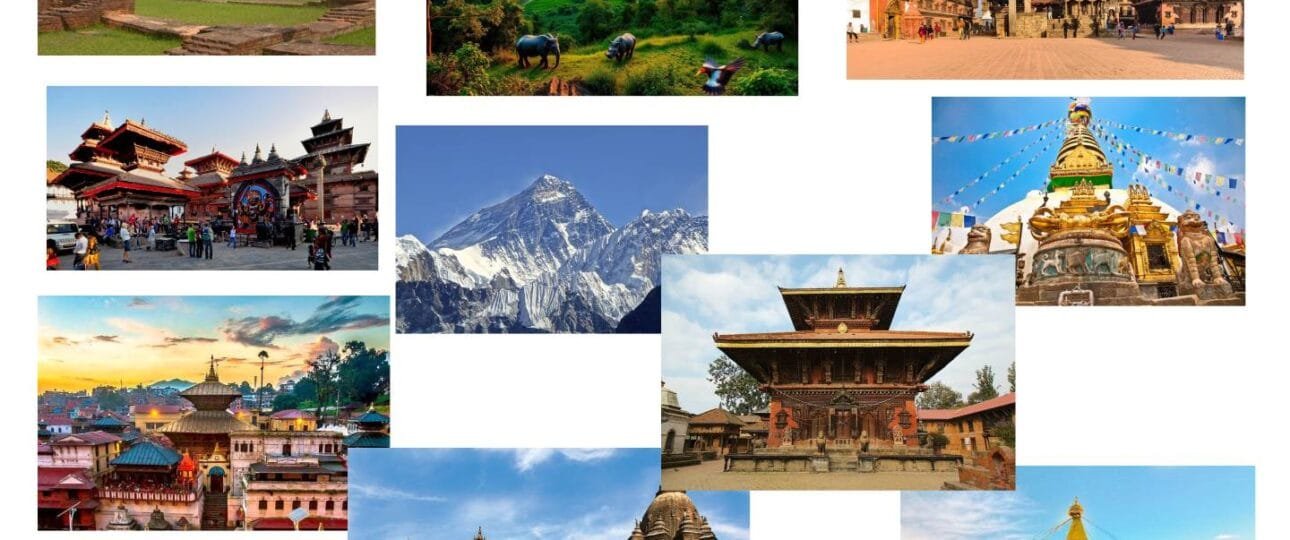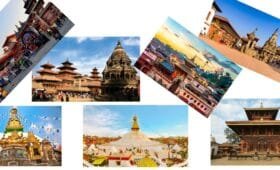Nepal, a country known for its majestic mountains and rich cultural traditions, is home to several UNESCO World Heritage Sites that reflect the country’s unique history, culture, and biodiversity. These sites, both cultural and natural, are essential for understanding Nepal’s identity and its global significance. From ancient temples and stupas to lush national parks and sacred pilgrimage sites, Nepal’s UNESCO World Heritage Sites offer a glimpse into the diverse cultural and natural heritage that has shaped the country for centuries.
In this article, we will take a closer look at the UNESCO World Heritage Sites in Nepal, exploring the cultural and historical importance of these landmarks, their preservation efforts, and their significance to travellers and locals alike.
1. Kathmandu Valley: A Cultural Hub of Nepal
The Kathmandu Valley is home to seven UNESCO World Heritage Sites, making it one of the most historically and culturally rich regions in Nepal. These sites include ancient temples, stupas, and palaces that showcase the brilliance of Nepalese architecture, art, and spirituality. The Kathmandu Valley’s inclusion as a UNESCO World Heritage Site is a recognition of its immense cultural value.
1.1 Kathmandu Durbar Square

Kathmandu Durbar Square, located in the heart of the capital city, is one of the most iconic heritage sites in Nepal. This former royal palace complex is home to beautiful temples, palaces, and courtyards that have stood for centuries. Among the most notable structures is the Hanuman Dhoka Palace, which served as the seat of the Malla kings in the medieval period. The square is also home to the Kasthamandap (a wooden pavilion), which is believed to have been the origin of the city’s name.
Kathmandu Durbar Square is a living museum, with vibrant festivals, local artisans, and historical monuments that narrate the fascinating history of Nepal.
1.2 Swayambhunath Stupa (Monkey Temple)

Known as the Monkey Temple, Swayambhunath Stupa is one of the oldest and most important religious sites in Nepal. Perched on a hilltop, this Buddhist stupa offers panoramic views of Kathmandu Valley. It is a symbol of Nepalese culture and spirituality, attracting both Buddhist pilgrims and tourists alike. The stupa’s intricate carvings, statues, and iconic prayer wheels make it a must-visit destination for those seeking to understand Nepal’s deep Buddhist heritage.
1.3 Pashupatinath Temple

The Pashupatinath Temple, dedicated to Lord Shiva, is one of the holiest Hindu temples in Nepal. Situated on the banks of the Bagmati River in Kathmandu, this temple complex is renowned for its religious significance and its stunning architecture. Pashupatinath is an important pilgrimage site for Hindus worldwide, and its main pagoda-style temple, with its golden roof and intricate wooden carvings, attracts thousands of devotees each year.
The temple complex is surrounded by several other shrines, cremation ghats, and a vibrant marketplace, creating a deeply spiritual atmosphere.
1.4 Boudhanath Stupa

The Boudhanath Stupa is one of the largest Buddhist stupas in the world and a UNESCO World Heritage Site in Kathmandu. This stupa is a significant centre for Tibetan Buddhism and is surrounded by monasteries, temples, and shops. Visitors can explore the stupa, which is adorned with colourful prayer flags and mandala designs while watching the monks perform rituals and prayer ceremonies. The stupa’s large size and spiritual energy make it one of the most visited and revered sites in Nepal.
1.5 Patan Durbar Square

Located in the ancient city of Patan, Patan Durbar Square is another UNESCO World Heritage Site in the Kathmandu Valley. Known for its stunning architecture, the square is home to beautiful temples, shrines, and palaces. Highlights include the Mahabouddha Temple, made of thousands of terracotta tiles, and the Patan Museum, which houses one of the finest collections of traditional Nepalese art.
Patan Durbar Square is also a hub for local culture, with festivals, exhibitions, and performances that showcase the art and traditions of the Newar people.
1.6 Bhaktapur Durbar Square

Bhaktapur Durbar Square is one of the best-preserved medieval city squares in Nepal. Known for its rich history and traditional Newar architecture, the square is home to iconic structures like the Vatsala Temple, the Bhaktapur Durbar (Palace), and the Fifty-Five Window Palace. Visitors can also explore the Patan Museum, which showcases sculptures, religious artefacts, and historical items from the Malla period.
Bhaktapur is also famous for its festivals, especially Bisket Jatra, which attracts large crowds to celebrate the arrival of spring.
1.7 Changu Narayan Temple

The Changu Narayan Temple is located on a hilltop near Bhaktapur and is one of the oldest Hindu temples in Nepal. This temple, dedicated to Lord Vishnu, dates back to the 4th century and is a masterpiece of Nepalese architecture and art. The temple complex is home to intricate carvings, stone sculptures, and inscriptions that offer insight into the rich history and culture of Nepal.
2. Lumbini: The Birthplace of Lord Buddha

Lumbini, located in the Rupandehi district of Nepal, is one of the most important pilgrimage sites for Buddhists around the world. It is believed to be the birthplace of Lord Buddha, and the site is home to the Maya Devi Temple, where the Buddha was born in 623 BCE. Lumbini is a UNESCO World Heritage Site due to its religious and cultural significance.
The site includes the Lumbini Garden, the Ashoka Pillar (erected by Emperor Ashoka in 249 BCE), and several monasteries built by different countries. Lumbini remains a centre for Buddhist teachings and attracts pilgrims from all over the world who come to meditate and learn about the life of Buddha.
3. Chitwan National Park: A Natural Heritage Site

Nepal is not only known for its cultural heritage but also its rich biodiversity. Chitwan National Park, located in the southern part of the country, is a UNESCO World Heritage Site recognized for its natural beauty and diverse wildlife. Established in 1973, the park is home to endangered species such as the one-horned rhinoceros, Bengal tiger, and Gharial crocodile.
Chitwan National Park also holds cultural significance for the indigenous Tharu people, who have lived in the region for centuries. The park offers a unique blend of nature and culture, with wildlife safaris, bird watching, and cultural experiences available to visitors.
4. Sagarmatha National Park: The Roof of the World

Sagarmatha National Park, which includes Mount Everest, is one of Nepal’s most iconic natural heritage sites. As a UNESCO World Heritage Site, it is recognized for its breathtaking landscapes, biodiversity, and spiritual significance. Mount Everest, known as Sagarmatha in Nepali, is the highest peak in the world and draws mountaineers and trekkers from across the globe.
The national park is home to unique wildlife, including the snow leopard, Himalayan tahr, and red panda, as well as several Sherpa villages that have preserved their cultural heritage for generations. Treks to Everest Base Camp allow visitors to experience the stunning beauty of the Himalayas while learning about the region’s rich cultural history.
The Importance of Preserving Nepal’s UNESCO World Heritage Sites
The preservation of Nepal’s UNESCO World Heritage Sites is crucial to maintaining the country’s cultural and natural identity. These sites not only attract millions of tourists every year but also serve as important symbols of Nepal’s history, art, and spirituality. Conservation efforts are essential to safeguard these sites from natural disasters, urban development, and environmental degradation.
The Nepalese government, along with local communities and international organizations, works to ensure that these heritage sites are protected and that sustainable tourism practices are promoted. By visiting these sites, travellers contribute to their preservation and help support local communities while gaining a deeper understanding of Nepal’s unique cultural heritage.
Conclusion: Exploring Nepal’s UNESCO World Heritage Sites
Nepal’s UNESCO World Heritage Sites offer a window into the country’s rich cultural history, religious traditions, and natural beauty. From the ancient temples and stupas in the Kathmandu Valley to the sacred birthplace of Buddha in Lumbini and the diverse wildlife of Chitwan National Park, these sites are vital to understanding the heart and soul of Nepal. By visiting these UNESCO World Heritage Sites, travellers can experience Nepal’s deep spiritual connection, unique architecture, and breathtaking landscapes, all while supporting efforts to preserve these invaluable treasures for future generations.





[…] Nepali architecture is a remarkable fusion of Hindu, Buddhist, and indigenous elements. The ancient cities of the Kathmandu Valley, such as Kathmandu, Patan, and Bhaktapur, are famous for their intricate and beautifully crafted buildings, many of which are UNESCO World Heritage Sites. […]
[…] The historic Changu Narayan Temple, a UNESCO World Heritage Site. […]
[…] The Nagarkot to Changu Narayan Trek is a delightful journey that combines panoramic Himalayan views with rich cultural heritage. This one-day trek is perfect for beginners and those short on time, offering a seamless blend of nature and history. The trail takes you through peaceful villages, terraced farmlands, and serene forests before culminating at the ancient Changu Narayan Temple, a UNESCO World Heritage Site. […]